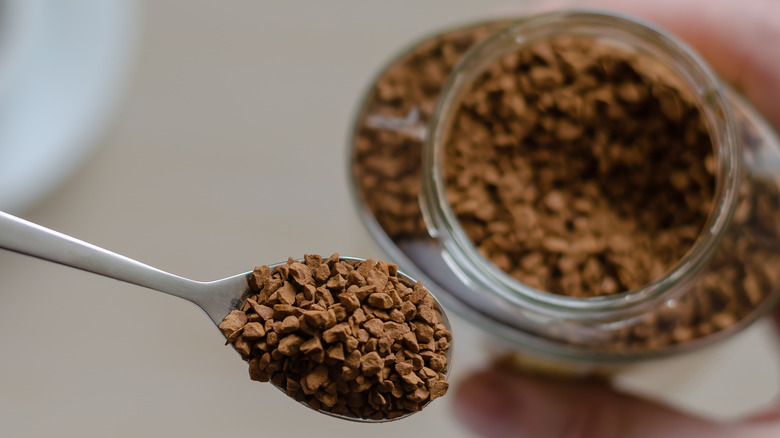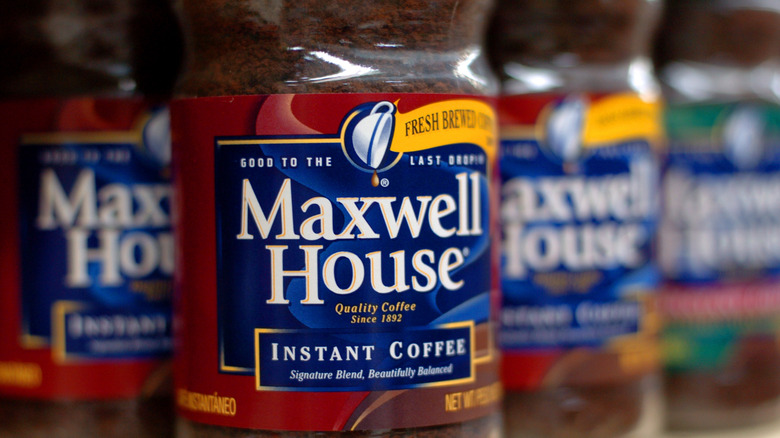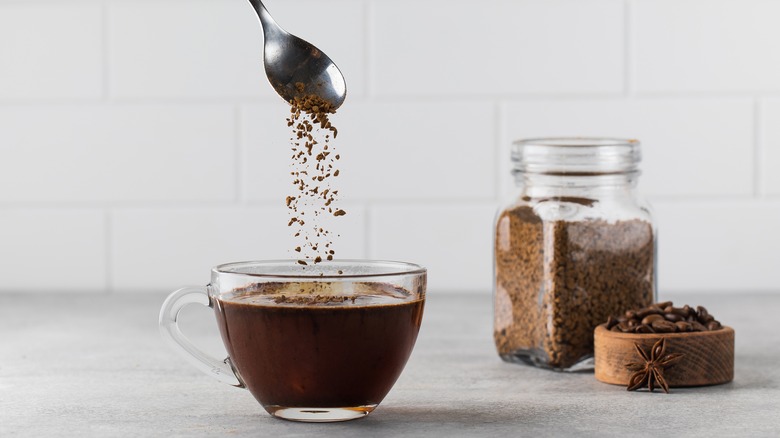What Exactly Is In Instant Coffee?
Have you ever had a morning when you stumbled into the kitchen and discovered that you forgot to buy more coffee? This very scenario is why it's worth keeping a backup supply of instant coffee in the cupboard. In that moment of bleary-eyed grogginess, you'll be saved from having to leave the house un-caffeinated to either buy more coffee or wait in line at the cafe.
Instant coffee and ground coffee will give you a hot beverage, but by quite different means; there's a big difference between the two, leading to why they aren't brewed in the same way. To get ground coffee, whole, roasted coffee beans are run through a bean grinder to pulverize them, then the grounds are infused with hot water and strained. Despite what some purists may tell you, instant coffee is real coffee but instead of wetting actual beans, it's made from liquid coffee concentrate — or coffee that's brewed in the normal fashion and then dehydrated into clumps, granules, or a powder. The benefit of this is that the dried liquid java can be easily reconstituted with hot water and no other special equipment.
Instant coffee is made in two ways
Instant coffee is a dehydrated version of brewed coffee, and there are two main ways that it's produced. One method is known as spray-drying or hot-air drying. This process begins with brewing a very concentrated batch of coffee, which is then sprayed into a large chamber. Hot air is blown through the chamber and water in the coffee evaporates, leaving dry coffee granules behind. This method is the oldest way of making instant coffee; it was patented in 1890 by New Zealand coffee proprietor David Strang. While this process is fairly straightforward, it also has the unfortunate side effect of creating a poorer-tasting coffee. This is due to high heat in the chamber destroying flavor compounds present in the bean oils.
The second method to make instant coffee is freeze-drying, which also begins with brewed, concentrated coffee. It's flash-frozen at a temperature of around -40°F. The frozen water is then removed from the brew in a vacuum chamber with just a slight increase in heat — high enough to turn the water to vapor but not so hot that it affects the flavor of the coffee. Freeze-dried instant coffee costs more because it's a more complicated process, but the process also gives coffee fans a much better-tasting cuppa.
Convenient? Yes. Delicious? Not always.
Instant coffee has a lot of things in its favor: it's real coffee that's easy to make in a jiffy. Because it doesn't require any brewing gadgets or equipment, it can be dispensed in vending machines and tight spaces like planes and trains. However, the reason instant coffee gets a bad rap and why many assume it's fake is because it often tastes pretty crummy. The worst instant coffees taste cheap, bitter, and watery, lacking the richness and depth of coffee brewed from ground beans. Coffees made through spray-drying can be blamed for this lack of flavor in many cases, so opting for freeze-dried instant coffee will help ensure a better-tasting brew. Another reason it tastes inferior is the quality of the bean used, which is typically Robusta, a more bitter bean compared to Arabica coffee beans.
The good news is that, as in many other areas of the food and beverage world, instant coffee is seeing a rebirth thanks to craft creators. Instant coffee used to be the domain of primarily big-name coffee players like Starbucks, Folgers, Nescafé, and Maxwell House. Today coffee producers like Intelligentsia, Canyon, and Verve create better-tasting (although more expensive) instant coffees and instant espressos, made with care and quality coffee beans. For coffee lovers, a stash of instant coffee is an invaluable backup to fresh-brewed; thankfully it's possible to have a cup of instant that tastes good too.


